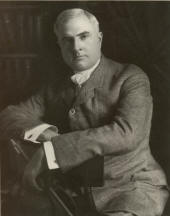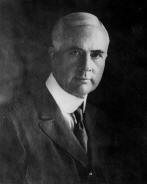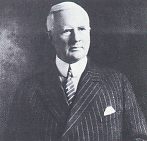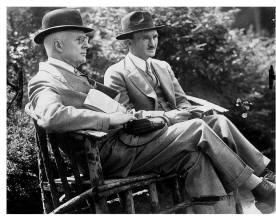|

Samuel Culbertson (far
right) at the Kentucky Derby in 1934, when he was
President of Churchill Downs.
From left to right: Colonel Matt Winn, "Mr. Kentucky Derby"
and General Manager of Churchill Downs;
Churchill Downs Attorney, Maurice L. Galvin; Kentucky Governor Ruby Laffoon
(served 1931-1935); Daniel E. O'Sullivan, resident manager of Churchill
Downs; US Postmaster General James Farley; former US Senator and former
President of the Kentucky Jockey Club, Johnson N. Camden Jr.; and Samuel A.
Culbertson.
(By the way, Cavalcade won the Derby that year.)
from the Samuel
Culbertson Mansion Collection of original family photographs
 Samuel
Alexander Culbertson began as a classic late 19th / early 20th Century tycoon capitalist. Samuel
Alexander Culbertson began as a classic late 19th / early 20th Century tycoon capitalist. In 1884, at age 22, he became the youngest cashier officer of any bank in
the country. But then, it was his daddy's bank. Aside from making
money, he is also known for his contributions with the group establishing the Louisville Park
System and number of other philanthropic activities.
In 1884, at age 22, he became the youngest cashier officer of any bank in
the country. But then, it was his daddy's bank. Aside from making
money, he is also known for his contributions with the group establishing the Louisville Park
System and number of other philanthropic activities.
It is an irony that two of Samuel's
nephews, Glover & Percy, were essentially written out of Samuel's father's
will in 1892, save for $100 each, the reason being that they were engaged in
the activity of horse racing. Sam would have to keep his interests in
that field a secret until after his father's death, but he would then jump
into it in a big sort of way.
He became associated with the group that
purchased Churchill Downs in 1902, including Col. Matt Winn, Mayor Charles
Grainger & others. From 1919 until 1928, after a stint in the US
Army (he enlisted at nearly 60 years of age as a private near the end of
WWI), Culbertson served on the
Churchill Downs Board of Directors. He became President of Churchill Downs and the American
Turf Association in 1928, and Chairman of the Board from 1937 until his
passing in late 1948.
If you are familiar with the famous Kentucky Derbies of War Admiral, Gallahadion,
Count Fleet, Gallant Fox, Whirlaway and Citation, you remember the Kentucky Derby era when Samuel
Culbertson was at the top of it all.. But it is with the Derby won by Burgoo King in 1932 that we
best remember Samuel Culbertson, for it is then that he started one of the
Derby's most famous traditions by conceiving and commissioning the
very first "Garland of Roses," with all of it's unique symbolism, to
annually adorn the Kentucky Derby champion.
In the early days, the Derby was nothing like the extravagant affair we know today.
Along with Colonel Matt Winn, Samuel played the pivotal role in bringing the
Derby to the prominence that has been growing ever since. Some of the first Derby
Balls were held in this house in our third floor ballroom. We have talked to
people who still remembered the affairs. Third Street was all but
impassable. Crowds gathered on the street and sidewalks near the house to
hear the strains of music which emanated from within.
|

|
In his memoirs of 1945, Col. Matt
Winn remarked on Samuel Culbertson: "The Beau Brummell of
our organization — maybe I should extend the territory to include
the entire City of Louisville — is Samuel A. Culbertson, the
Chairman of our Board. Sam is the descendent of one of the
oldest and most famous families in Kentucky. In his earlier
years, he divided his time, spending part of it in Newport, or at
Tuxedo, another part in New York City; the rest of it in Kentucky.
Sam's hair long since has turned to silver, but he is still very
active in club and social affairs, and is the perennial cotillion
leader."
— Down the
Stretch, Matt J WInn as told to Frank
G Menke 1945 |
 |

1935
Mr. Culbertson's life
is well summed up in testimonials
from local newspapers at the time of his passing:
From the Louisville
Times, December 13, 1948:
"If anyone ever looked his part, it was Samuel A. Culbertson. He
was a man of wealth, a member of upper financial and social circles, a
conservative in politics, an upholder of the conventions and
proprieties. And any stranger would have guessed it at sight of
him. Tall and straight, keen of eye, perfectly tailored, perfectly
mannered, too, though not austerely, his hair a distinguished grey which
seemed premature long after it wasn't, Mr. Culbertson was the beau ideal
portrait of what he was to all of those to all of those who have grown up in
this community within this century. They were glad that age dealt so
gently with one who played so ably the part he looked. Another is gone
of whom it has to be said that Louisville will never seem like Louisville
without him."
From the Courier-Journal,
December 12, 1948:
"A chivalrous gentleman of the old school...was Samuel A. Culbertson,
former president of Churchill Downs. ...Tall and erect, the handsome
white-haired Culbertson was known for his generosity and chivalry.
"In former days his tallyho carriage bound for
the race track provided a spectacle for pedestrians. The carriage was drawn
by four high-stepping horses and attended by a coachman, footman, and a
small Negro boy, 'Tiger,' whose job it was to open the door.
Never Wore a Topcoat
"Always a meticulous dresser,
Culbertson also was an impressive figure when he attended services at Warren
Memorial Presbyterian Church. He wore spats, white gloves, and a
derby.
"But although he was very fond of the church's
pastor, Culbertson liked the service to be over promptly at noon because his
dinner was served shortly afterward.
"Culbertson's bearing and attire were
impressive, but one of his idiosyncrasies was that he never wore a
topcoat. Even in the coldest weather he refused to wear one.
"Culbertson was born in New Albany August 15,
1862, but after 1897 he spent all his years on the Kentucky side of the
Ohio.
Sons models for Book
"He married Louise Craig of Pewee
Valley who died 10 years ago at their summer home in Manchester, Mass.
A friend once remarked:
'They should be a very happy couple. They are the
handsomest pair in Louisville, have the handsomest sons, and live in the
handsomest house.'
"Their sons were models for the 'Two Little
Knights of Kentucky' in Annie Fellows Johnston's 'Little Colonel' series ...
Parties were famous
"Mr. and Mrs. Culbertson were noted
for their formal and elegant dinner parties and the dances they gave in the
in the ballroom on the third floor of their Third Street home.
"Culbertson became chairman of the
board of directors of Churchill Downs 10 years ago and continued in that
post until his death.
"He was never known to bet on the races, but
he was proud of the pageantry of the Derby. Almost reverently, he
witnessed presentations to Derby winners.
"Until recently Culbertson walked to his
office in the Kentucky Home Life Building. He was a director of the
Citizens Fidelity Bank & Trust Company, Federal Chemical Company, and
American Turf Association, holding company for Churchill Downs....He was a
director of Speed Museum and for several years was chairman of the board of
trustees of the Warren Memorial Presbyterian Church...."
From the Courier-Journal,
December 13, 1948:
"...There is hardly a tradition of the community in which his life and
memories were not rooted.
"Mr. Culbertson will be remembered for the
distinction of his manner and appearance as well as for the loyal part he
took in keeping intact the institutions with which Louisville is most widely
identified. In a way, he was himself an institution. And it is
noteworthy that the account of his long and serene life accurately described
the zest of his participation to the last in the affairs that had multiplied
so greatly around him. Far past man's allotted span he remained
active.
"It is good to think of this as a community
which so endears itself to its dwellers that they are loathe to let go of
even a little of its flavor and associations."
A Who's Who of an Era of Derby
History: A Meeting of the Directors of the American Turf Association,
1930s.

Frazier Le Bus, Arthur B Hancock, Henning Chambers, Samuel A Culbertson, C Bruce
Head, Samuel H Stone, Edward J Hughes
Charles Bidwell, Stuyvesant Peabody, Maurice Galvin, Colonel Matt Winn, Johnson
N Camden
— from Down the
Stretch
More on Samuel
Culbertson
More photos of Sam Culbertson
******************
|